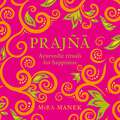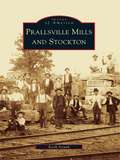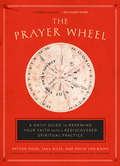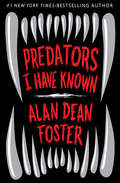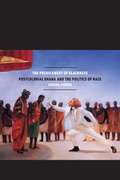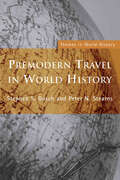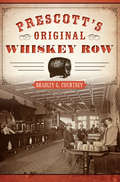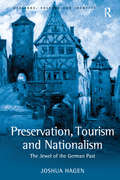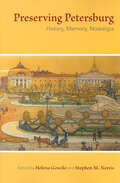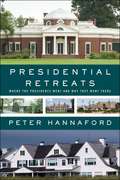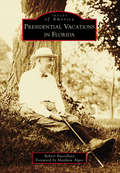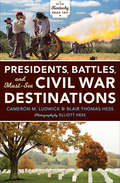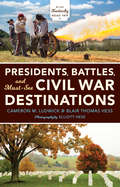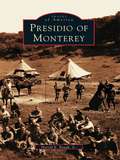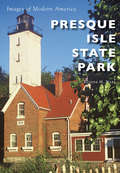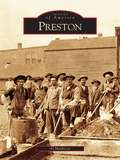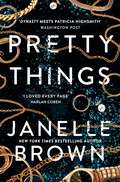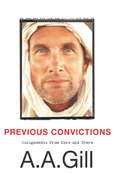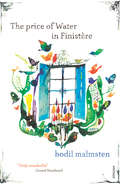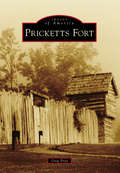- Table View
- List View
Prajna: Ayurvedic Rituals For Happiness
by Mira ManekBeautifully simple age-old rituals for modern-day living that will enhance your wellbeing, and give you back your zest for life. Prajña is the Sanskrit word for wisdom. Ayurveda is one of the world's oldest healing systems, rooted in the principle of a mind-body-spirit connection. Ayurveda comes from the Sanskrit words 'ayur' and 'veda', respectively 'life' and 'knowledge', meaning 'knowledge of life'.This book dips into this ancient knowledge base, extracts the essence of this Indian philosophy and revives a wealth of timeless rituals to effect positive change in our lives.In India, from the prayers and chanting of mantras to daily yoga and breathing exercises, these rituals are an intrinsic part of everyday existence.The book offers rituals and routines for the entire day, from the moment you wake up and need the energy and positive mindset to help you start the morning, to night-time practices that allow you to wind down, relax and get the most benefit from the healing power of sleep. In between there are numerous breathing exercises, meditations, mindfulness techniques, yoga stretches, simple recipes to enjoy and other rituals to observe throughout the day. All are based on ancient Indian Ayurvedic wisdom and practices, tried and tested over the centuries.(P) 2019 Heading Publishing Group Ltd
Prajna: Ayurvedic Rituals For Happiness
by Mīra Manek'Each page solidifies my commitment to living a life of ritual, observance and beauty' Kathryn Budig'Mira's book is a timely reminder to love yourself - to give yourself that much needed moment to stop and breathe' Asma KhanBeautifully simple age-old rituals for modern-day living that will enhance your wellbeing and bring you happiness.Prajna is the Sanskrit word for wisdom, and this book brings the ancient wisdom of Ayurveda into your life by guiding you through simple practices for every day and every occasion.Ayurveda is one of the world's oldest healing systems, rooted in the principle of a mind-body-spirit connection that is more relevant than ever to our busy modern lives. This book extracts the essence of this Indian philosophy and provides a wealth of timeless rituals to effect positive change.Prajna offers rituals and routines for the entire day, from the moment you wake up and need the energy and positive mindset to help you start the morning, to night-time practices that allow you to wind down, relax and get the most benefit from the healing power of sleep. In between there are numerous breathing exercises, mindfulness techniques, yoga stretches and simple recipes to enjoy, all to help you destress and reset, bringing you back to yourself and to lasting peace and happiness.
Prallsville Mills and Stockton
by Keith StrunkThe Delaware River Valley has attracted industrial and political visionaries, thinkers, and artists for more than 300 years. In its taverns, political discourse fanned the flames of revolution, and its beauty has inspired artists, actors, and writers from Edward Hicks to Richard Rodgers to Dorothy Parker. In 1794, John Prall Jr. acquired a property nestled next to the river that included a corn or gristmill and a sawmill. The mills became the heart of Prallsville, a village industrial complex that would continue to function into the early 20th century. Early economic and community needs closely linked Prallsville to neighboring Brookville and Stockton, and in 1898, they incorporated to become Stockton. The vintage images in Prallsville Mills and Stockton provide a glimpse of the tenacious and generous people that survived floods, fires, and industrial mishaps to prosper in their home along the banks of the Delaware.
The Prayer Wheel: A Daily Guide to Renewing Your Faith with a Rediscovered Spiritual Practice
by Jana Riess Patton Dodd David Van BiemaAward-winning religion journalists describe a recently rediscovered medieval prayer tool that provides fresh inspiration and daily prayers for contemporary Christians.All people of faith struggle at times to sustain a flourishing prayer life--a loss felt all the more keenly in times like ours of confusion, political turbulence, and global calamity. The Prayer Wheel introduces an ancient prayer practice that offers a timeless solution for the modern faithful.The Prayer Wheel is a modern interpretation of the Liesborn Prayer Wheel, a beautiful, almost wholly forgotten, scripture-based mode of prayer that was developed in a medieval times. The Liesborn Prayer Wheel resurfaced in 2015 in a small private gallery near New York's Metropolitan Museum of Art. It faithfully and beautifully presents seven prayer paths for personal or group use. Each path invites contemplation on the "big ideas" of the Christian faith--the Lord's Prayer, the Beatitudes, the gifts of the Holy Spirit, and key words from the life of Christ.In the tradition of lectio divina and walking a labyrinth, The Prayer Wheel simply and directly takes readers into a daily, wholly unique encounter with God. As the prayers in this book unfold, readers will find an appealing guide for contemplation, a way of seeing God in new ways, and an essential new tool for Christian formation.
Predators I Have Known
by Alan Dean FosterAn adrenaline-fueled travel memoir of life in the wild among the planet&’s most ferocious and fascinating predators.Over the last forty years, New York Times–bestselling author Alan Dean Foster has journeyed around the globe to encounter nature&’s most fearsome creatures. His travels have taken him into the heart of the Amazon rain forest on the trail of deadly tangarana ants, on an elephant ride across the sweeping green plains of central India in search of the elusive Bengal tiger, and into the waters of the Australian coast to come face-to-face with great white sharks. Packed with pulse-pounding adventure and spiked with rapier wit, Predators I Have Known is a thrilling look at life and death in the wild.
The Predicament of Blackness: Postcolonial Ghana and the Politics of Race
by Jemima PierreWhat is the meaning of blackness in Africa? While much has been written on Africa's complex ethnic and tribal relationships, Jemima Pierre's groundbreaking The Predicament of Blackness is the first book to tackle the question of race in West Africa through its postcolonial manifestations. Challenging the view of the African continent as a nonracialized space--as a fixed historic source for the African diaspora--she envisions Africa, and in particular the nation of Ghana, as a place whose local relationships are deeply informed by global structures of race, economics, and politics. Against the backdrop of Ghana's history as a major port in the transatlantic slave trade and the subsequent and disruptive forces of colonialism and postcolonialism, Pierre examines key facets of contemporary Ghanaian society, from the pervasive significance of "whiteness" to the practice of chemical skin-bleaching to the government's active promotion of Pan-African "heritage tourism. " Drawing these and other examples together, she shows that race and racism have not only persisted in Ghana after colonialism, but also that the beliefs and practices of this modern society all occur within a global racial hierarchy. In doing so, she provides a powerful articulation of race on the continent and a new way of understanding contemporary Africa--and the modern African diaspora.
Premodern Travel in World History (Themes in World History)
by Peter Stearns Stephen GoschThis book features some of the greatest travellers in human history – people who undertook long journeys to places they knew little or nothing about. From Roman tourists, to the establishment of the Silk Road; an epic trek round China and India in the seventh century, to Marco Polo and through to the first speculations on space travel, Premodern Travel in World History provides an overview of long-distance travel in Afro-Eurasia from around 400BCE to 1500. This survey uses succinct accounts of the most epic journeys in the premodern world as lenses through which to examine the development of early travel, trade and cultural interchange between China, central Asia, India and southeast Asia, while also discussing themes such as the growth of empires and the spread of world religions. Complete with maps, this concise and interesting study analyzes how travel pushed and shaped the boundaries of political, geographical and cultural frontiers.
Preparing for Your Move Abroad
by Rona HartThis comprehensive, step-by-step guide is designed to prepare you for your move abroad and to enable you to manage the transition effectively. Alone in the market, it combines the practical, cultural, and psychological aspects of relocation, and helps to allay the fears and reduce the stresses that accompany this major event in a person’s life. Preparing For Your Move Abroadfollows a typical relocation timeline, taking you from your first step – the decision to move – to your integration into the host society, and through every step between these two points. Uniquely it offers: * A strong knowledge base for every stage of the relocation journey * A strategy to manage the issues at hand * Psychological preparation * An action plan, presented through exercises, practical steps to consider, checklists, and many easy-to-use tools It deals with the challenge of change by pulling together the practical, cultural, and psychological aspects of relocation and addressing them at each phase of the process. This distinctive approach helps you to develop three essential skills: systematic organization, cultural flexibility, and psychological resilience. These skills are crucial for successful change management, and can be put to use in any new culture, anywhere in the world. Moving to a new society invariably induces a degree of culture shock – largely the result of “change overload. ”Preparing For Your Move Abroadpresents a tried and tested strategy to help you manage the experience and quickly recover. No other book addresses this phenomenon, or attempts to help readers develop the skills to cope with it. The book aims to turn the challenges of relocation into opportunities for growth. By equipping you with essential knowledge, tools, and skills, it will help you to anticipate what lies ahead, address the challenges presented by your move with clarity and confidence, and make your transition successful, stress-free, and much more enjoyable.
Prescott’s Original Whiskey Row
by Bradley G. CourtneySome of the oldest, most notorious saloons in the American West lined the streets of Prescott's Whiskey Row. Dating back to 1864, the remote mountain town thrived on its mining and cattle industries during the day and raised hell at night when dusty outlaws and pioneers like Virgil Earp and Doc Holliday crowded Row saloons to quench their thirsts. Whiskey Row bore witness to legendary gunfights, murders and other curious tales, like that of Baby Bell, aka Chance Cobweb Hall, known today as Arizona's most famous saloon story. From crooked gambling operations and barroom brawls to the devastating fire of 1900, author and historian Bradley G. Courtney explores the colorful stories of Whiskey Row.
Preservation, Tourism and Nationalism: The Jewel of the German Past (Heritage, Culture and Identity)
by Joshua HagenSince its discovery by German romantics and nationalists, Rothenburg has been an established icon of the German nation and its medieval past. By tracing Rothenburg's historical development as a place of national importance, this book examines the cultural politics of historical preservation and tourism in general. In exploring the shifting practice and importance of tourism in Rothenburg and how this relates to broader debates about German culture and identity, Preservation, Tourism and Nationalism offers an important and original perspective on the changing dynamics of romanticized historical landscapes and how events are used to further national, cultural and political agendas. It also analyses the changing practices of historical preservation, and in particular, how historic preservation in Rothenburg reflects a desire to make it more historic and more German. With important insights into what it means to be German, how Germans relate to the past and how the answers to these questions have changed over time, this richly illustrated and detailed volume offers an important narrative of the rise, evolution and contestation of memory in German culture.
Preserving Petersburg: History, Memory, Nostalgia
by Helena Goscilo and Stephen M. Norris“Goscilo and Norris’ innovative anthology provides Slavic scholars with a panoramic view of the city’s literary, pictorial and social manifestations.” —Europe-Asia StudiesFor more than three centuries, St. Petersburg, founded in 1703 by Peter the Great as Russia’s westward-oriented capital and as a visually stunning showcase of Russia’s imperial ambitions, has been the country’s most mythologized city. Like a museum piece, it has functioned as a site for preservation, a literal and imaginative place where Russians can commune with idealized pasts. Preserving Petersburg represents a significant departure from traditional representations. By moving beyond the “Petersburg text” created by canonized writers and artists, the contributors to this engrossing volume trace the ways in which St. Petersburg has become a “museum piece,” embodying history, nostalgia, and recourse to memories of the past. The essays in this attractively illustrated volume trace a process of preservation that stretches back nearly three centuries, as manifest in the works of noted historians, poets, novelists, artists, architects, filmmakers, and dramatists.“The collection truly sparkles as the contributors each in turn take up this snuff box of a city . . . and breathe movement and life into the idealized Petersburg museum.” —Gregory Stroud, Bennington College“This collection brings together history, literature, architecture, and the politics of memory.” —Choice“An interesting and important contribution to existing scholarship on St. Petersburg’s myth, cult, and text . . . this volume is distinctive.” —Catharine Theimer Nepomnyashchy, Columbia University“A truly innovative contribution to the scholarship on Petersburg . . . The volume should be read by all serious Slavic scholars.” —Emily Johnson, University of Oklahoma
Presidential Retreats: Where the Presidents Went and Why They Went There
by Peter HannafordA fascinating history of U.S. presidential vacation spots--collected for the first time in one guide that covers everything from Mount Vernon to Kennebunkport to Camp David.Where do you go to relax when you're the leader of the free world? Even the president needs to get away from it all sometimes. From George Washington to Barack Obama, each of our presidents has sought solace from the tightly structured daily routines of the White House. As Ronald Reagan once said of his California ranch, "I do some of my best thinking there." Peter Hannaford takes readers on a fascinating armchair vacation with each of our leaders, offering unique historical context for the why and the where of their chosen retreats. Which president asked visiting foreign dignitaries to send him seeds to plant at his family home? Who called his vacation property "Sherwood Forest" because it was "a good place for an outlaw"? Which adventure-loving Commander-in- Chief set up a Summer White House in New York every year? Who liked to cruise aboard the presidential yacht when faced with momentous wartime decisions? Who polled the American people to help him decide where to vacation? Presidential Retreats explores a side of the American presidency that we don't often see--the downtime--as it offers an intriguing glimpse at the evolution of leisure time in this country.
Presidential Retreats
by Peter HannafordWhere do you go to relax when you're the leader of the free world? Even the president needs to get away from it all sometimes. From George Washington to Barack Obama, each of our presidents has sought solace from the tightly structured daily routines of the White House. As Ronald Reagan once said of his California ranch, "I do some of my best thinking there." Peter Hannaford takes readers on a fascinating armchair vacation with each of our leaders, offering unique historical context for the why and the where of their chosen retreats. Which president asked visiting foreign dignitaries to send him seeds to plant at his family home? Who called his vacation property "Sherwood Forest" because it was "a good place for an outlaw"? Which adventure-loving Commander-in- Chief set up a Summer White House in New York every year? Who liked to cruise aboard the presidential yacht when faced with momentous wartime decisions? Who polled the American people to help him decide where to vacation? Presidential Retreats explores a side of the American presidency that we don't often see--the downtime--as it offers an intriguing glimpse at the evolution of leisure time in this country.
Presidential Vacations in Florida (Images of America)
by Robert BuccellatoAbe Lincoln did not split rails in Tampa, and George Washington's cherry tree might not have been cut in Miami-Dade, but in Key West, the famous Harry S. Truman sign--"The Buck Stops Here"--still resides on the former president's Florida White House desk. A few hours north is the Kennedy bunker, complete with the presidential seal painted on the concrete floor just in case the Soviets started a nuclear war while Kennedy was vacationing in Palm Beach. Florida may not have a presidential homestead, but it contains the Disney resort where an embattled Richard Nixon exclaimed "I am not a crook" and the fishing hole where Chester A. Arthur discovered that he would not live to see a second term. It is the place where presidents have come to escape and let down their guards. For generations, the Sunshine State has turned commanders in chief into relaxed tourists, allowing them to juggle the formal functions of the office while reconnecting with their private lives. Illustrated with rare and candid photographs, Presidential Vacations in Florida is a book for any lover of the American presidency.
Presidents, Battles, and Must-See Civil War Destinations: Exploring a Kentucky Divided (My Old Kentucky Road Trip)
by Cameron M. Ludwick Blair Thomas HessTake a historical tour through the Bluegrass State, with fascinating facts, photos, and tips for travelers. As a border state and strategic territory, Kentucky was fiercely contested by the Union and the Confederacy and had ties to both Abraham Lincoln and Jefferson Davis. This book guides you to the sites of such battles as Perryville, Middle Creek, and Munfordville, and the childhood homes of both Lincoln and Davis as well as Mary Todd. You&’ll also learn about Kentucky&’s Confederate capital, Civil War governors, and its African American soldiers. Kentucky natives and adventure aficionados Cameron M. Ludwick and Blair Thomas Hess plot the course for a fun-filled road trip through history and across the Bluegrass State in Presidents, Battles, and Must-See Civil War Destinations.
Presidents, Battles, and Must-See Civil War Destinations: Exploring a Kentucky Divided
by Cameron M. Ludwick Blair Thomas Hess Elliott HessAs a border state and strategic territory, Kentucky was fiercely contested by the Union and the Confederacy and had ties to both Abraham Lincoln and Jefferson Davis. Kentucky natives and adventure aficionados Cameron M. Ludwick and Blair Thomas Hess plot the course for a fun-filled road trip through history and across the Bluegrass State in Presidents, Battles, and Must-See Civil War Destinations. Ludwick and Hess make planning a trip to historic Kentucky easy by exploring the history and stories behind each major site and highlighting nearby attractions you won't want to miss. Featuring step-by-step guidelines and exclusive tips on sites, monuments, and attractions from presidential homes to the best modern re-enactments, Presidents, Battles, and Must-See Civil War Destinations helps the whole family experience and enjoy history together.
Presidio of Monterey (Images of America)
by Harold E. Raugh Jr.The Presidio of Monterey is best known as the home of the post-World War II Defense Language Institute Foreign Language Center, the Department of Defense's acknowledged leader in foreign language training. It has, however, a much longer and rich history. After the United States seized Monterey in 1846, the U.S. Army began constructing Fort Mervine, which served a number of purposes until it was abandoned in 1866. In 1902-1903, a modern cantonment was built in the area. In 1904, the new post was officially renamed the Presidio of Monterey after a nearby Spanish fort established in 1770 that had fallen into disuse. Throughout the first half of the 20th century, the post was home to infantry and cavalry regiments, as well as an inductee reception center. The Military Intelligence Service Language School was moved to the Presidio of Monterey in 1946 and renamed the Army Language School in 1947; this evolved into the present-day Defense Language Institute Foreign Language Center.
Presque Isle State Park (Images of Modern America)
by Eugene H. WareLocated on a seven-mile peninsula on the shores of Lake Erie in Erie, Pennsylvania, Presque Isle State Park attracts four million visitors each year. With its designation in 1921, Presque Isle became the second state park in Pennsylvania. From this beginning, the citizens of Erie and surrounding areas developed an affinity and appreciation for the park. Presque Isle hasbeen left relatively unchanged over the years, and when improvements have been made, they have been executed in ways that have not altered the park's natural beauty. Through images gathered from the collections of the author, Erie County Historical Society, Pennsylvania Department of Conservation and Natural Resources, and various other local sources, Presque Isle State Park reflects the history and unique atmosphere of a park that has come to be known as "a place for all seasons."
Preston
by Al MathisonNestled in a lush valley along the banks of the Root River, Preston, Minnesota, is ideally located at the geographic center of Fillmore County. The earliest settlers found the area rich with everything they needed to build a community: timber, building stone, water power, and fertile soils. By 1860, Preston was a bustling business and government center in the heart of the most populous county in Minnesota. With rare and vintage photographs culled from the collection of the Fillmore County History Center, as well as from the albums and scrapbooks of many local residents, this book brings together nearly 200 images of Preston and its environs.
Pretty Things
by Janelle BrownSOON TO BE A LIMITED SERIES STARRING NICOLE KIDMAN'Pretty Things is awesome. Simple as that. I loved every page'Harlan Coben'It's Dynasty meets Patricia Highsmith' Washington Post 'Will keep you turning pages till the end'Attica Locke 'Outrageously entertaining'Times Crime Club Nina once bought into the idea that her fancy arts degree would lead to a fulfilling career. When that dream crashed, she turned to stealing from rich kids in L.A. alongside her wily Irish boyfriend, Lachlan. But when her mom falls ill, Nina puts everything on the line to help her, running her most dangerous scam yet.Vanessa is a privileged young heiress who wanted to make her mark in the world. Instead she becomes an Instagram influencer - but behind the covetable façade is a life marked by tragedy.After a broken engagement, Vanessa retreats to her family's sprawling mountain estate, a mansion of dark secrets. It's there that her path collides with Nina's and gives way to a winter of desire and aspiration, duplicity and revenge.'Smart, seductive, and utterly captivating' PopSugar'Deliciously fun' The Week'A can't-look-away story of and for our generation' Chandler Baker, author of Whisper Network'Literary suspense at its best' Angie Kim, author of Miracle Creek
Previous Convictions
by A. A. GillCritic, essayist and cultural savant A. A. Gill is probably the most widely read columnist in Britain. His books The Angry Island and A. A. Gill is away have found delighted fans in America as well, and sparked a loyal following. His new book of travel essays, Previous Convictions, ranges from Gill's nearby domestic locales of Glastonbury and the English countryside to Haiti, Guatemala, Pakistan and exotic, dangerous, downtown Manhattan. In this collection of notes from the corners of the globe, and sometimes from the edge of sanity, he confesses about his travels far and wide, "The more I see of the world, the less I think I understand. Familiarity breeds even more astonishment. The world just gets wider and deeper and weirder. "These pieces are wickedly funny, sometimes pointedly -- even purposely -- critical of many cultures and traditions, and always edifying and enchanting. As an adventurer and as a writer, Gill never disappoints; while he may take others to task for their customs, habits, idiosyncrasies and plain bad taste, his own indefatigable curiosity keeps him going back again and again for more, and provides us with spectacular entertainment along the way.
Previous Convictions: Assignments From Here and There
by Adrian GillThe second collection of travel writing (and other essays) by Britain's funniest and most feared critic.A.A. Gill is probably the most read columnist in Britain. Every weekend he entertains readers of the Sunday Times with his biting observations on television and his unsparing, deeply knowledgeable restaurant reviews. Even those who want to hate him agree: A. A. Gill is hopelessly, painfully funny. He is one of a tiny band of must-read journalists and it is always a disappointment when the words 'A. A. Gill is Away' appear at the foot of his column. This second book is a further collection of those absences; 22 travel pieces and essays on other subjects that belie his reputation as a mere style journalist and master of vitriol. This is writing of the highest quality and ambition.
Previous Convictions: Assignments From Here and There
by Adrian GillThe second collection of travel writing (and other essays) by Britain's funniest and most feared critic.A.A. Gill is probably the most read columnist in Britain. Every weekend he entertains readers of the Sunday Times with his biting observations on television and his unsparing, deeply knowledgeable restaurant reviews. Even those who want to hate him agree: A. A. Gill is hopelessly, painfully funny. He is one of a tiny band of must-read journalists and it is always a disappointment when the words 'A. A. Gill is Away' appear at the foot of his column. This second book is a further collection of those absences; 22 travel pieces and essays on other subjects that belie his reputation as a mere style journalist and master of vitriol. This is writing of the highest quality and ambition.
The Price of Water in Finistère
by Bodil Malmsten'In the same way as there's a partner for every person, there's a place. All you have to do is find the one that's yours among the billions that belong to someone else, you have to be awake, you have to choose.' With this conviction in mind, acclaimed Swedish writer Bodil Malmsten abandons her native country at the age of fifty-five and settles in Brittany. At the heart of this memoir is the conviction that the happiness to be found in Finistère will not allow itself to be, cannot be, expressed in writing. Embroidered around this seeming paradox are poignant, outraged and thought-provoking observations on the widest range of subjects: how not to buy plants, the elicit pleasures of bargain-hunting, the misery of writer's block, social democracy, racism, tulipomania, the stubbornness of bank managers, the controlling of moles and slugs, death, political hypocrisy, the delights of wild weather. Malmsten's passion and humour shine through every episode she describes, however minor, offering the reader a window onto a solitary life at once touching, thought-provoking and, occasionally, hilarious.
Pricketts Fort (Images of America)
by Greg BrayPricketts Fort was built on the land of Jacob Prickett in 1774, during what is known as Lord Dunmore's War. It provided sanctuary for local settlers before and during the American Revolution and was a safe haven from the attacks of American Indians until the Battle of Fallen Timbers in 1794. Constructed by local militia on a small rise near the confluence of Pricketts Creek and the Monongahela River, Pricketts Fort provided refuge for approximately 80 families. The fort itself was large by 18th-century standards. It had blockhouses at each corner, with walls 12 feet high and 110 feet long. Although the fort was never attacked, many outlying homes were, and a number of settlers lost their lives. Today, Pricketts Fort hosts visitors looking to learn more about day-to-day life on the western Virginian frontier.
